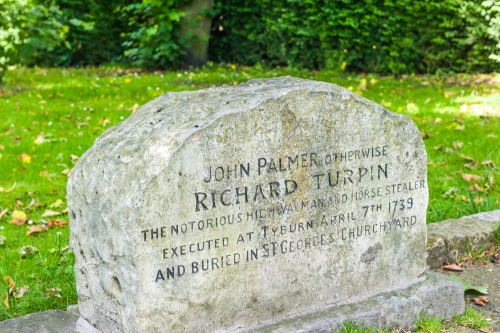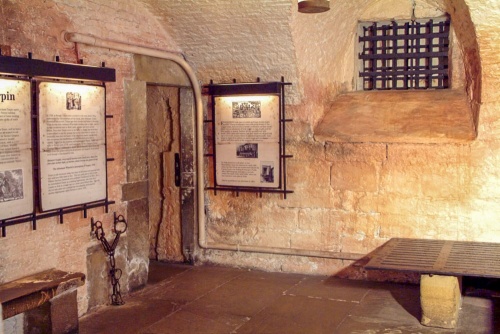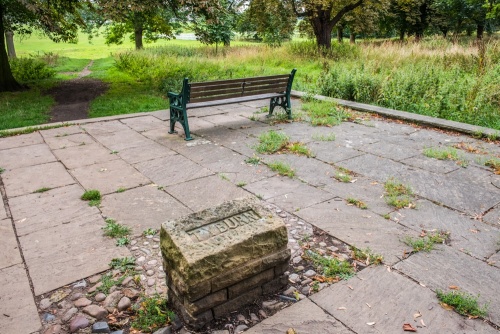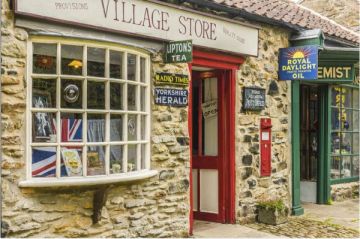
Tucked away on a quiet lane opposite St George's Roman Catholic Church in York is the grave of England's most infamous highwayman, Dick Turpin (1705-1739). Turpin was hanged at York Tyburn (Knavesmire) after a criminal career that involved poaching, house-breaking, armed robbery, murder, and - most famously - highway robbery.
A Life of Crime
Dick Turpin was born in 1705 to a butcher and innkeeper named John Turpin and his wife Mary. Turpin may have worked with his father, then married in 1725 and opened his own butcher shop in Buckhurst Hill, Essex.
He developed a sideline dealing in stolen game, and from there became a member of a violent gang of robbers known as The Gregory Gang. The gang broke into isolated farmhouses and forced the inhabitants to hand over their valuables. When most of the gang members were captured by the authorities Turpin turned to highway robbery.
Based in a cave in Epping Forest, Turpin and his partner Thomas Rowden waylaid travellers and stole anything valuable they could get their hands on. Turpin killed a man who attempted to apprehend him and fled to Yorkshire where he adopted the name John Palmer.
Turpin might have escaped punishment, but he couldn't stay out of trouble. He shot a cockerel and threatened to kill another man, for which he was arrested and put in gaol at Beverley. He wrote to his brother asking for help, but his brother refused to accept delivery of the letter.

It was returned to the post office where by chance it was seen by John Smith, the man who had taught Turpin to write decades before. Smith recognised the handwriting and was able to identify John Palmer as his former pupil Richard Turpin.
Smith was given a £200 reward and Turpin was transferred to York Castle gaol to await trial for murder. The cell where he was imprisoned has been preserved and is one of the star attractions in the York Castle Museum.
Dick Turpin was tried at the York Assizes in March 1739 and sentenced to death by hanging. He was taken to the 'York Tyburn' at Knavesmire, wearing a new frockcoat and shoes so that he would look stylish. He even paid five mourners to follow his cart. Turpin spoke calmly to the hangman, bowed to the spectators, and threw himself off the ladder.
To capitalise on his death a man named Richard Bayes quickly published a sensational (and largely fictitious) document called 'The Genuine History of the Life of Richard Turpin'. Much more embellishment followed; in 1834 William Ainsworth published a novel entitled 'Rookwood'.
One of Ainsworth's characters was Dick Turpin, and in the novel he makes a hell-for-leather ride from London to York aboard his horse Black Bess to establish an alibi for a crime. In the book, the 200-mile journey is completed in a day - a physical impossibility.
In fact, Turpin never made such a ride; the story goes back to Daniel Defoe's 1727 book 'A tour thro' the whole island of Great Britain' where he recounts the tale of William Nevison, who did indeed ride from London to York to establish an alibi - though not in 24 hours!

The gravestone reads:
John Palmer, otherwise
Richard Turpin
The notorious highwayman and horse stealer
Executed at Tyburn, April 7th 1739
and buried in St George's Churchyard
Is this really Turpin's Grave?
Is Dick Turpin really buried under the gravestone that bears his name? A recent investigation by James Sharpe, Professor Emeritus of Early Modern History at the University of York has cast doubt on the story.
Professor Sharpe points out that convicted felons were rarely buried in a marked grave. All other gravestones in the tiny graveyard date from well after Turpin's death. Perhaps even more telling is that there is no record of the gravestone before 1918.
Contemporary accounts say that Turpin was buried in the churchyard of St George's. Bodysnatchers broke into the grave and carried away the corpse, aiming to sell it for medical research. They were thwarted by a mob and the body was recovered.
To prevent the grave being robbed again the coffin was filled with slaked lime, which would have broken down the body quickly and made it unusable for medical research. The body was then reburied. But does it lie beneath the prominent gravestone that we see today?
Getting There
St George's graveyard resembles a small public park. It lies across Lead Mill Lane from St George's Church, a stone's throw from Fishergate Bar and across the River Foss from Clifford's Tower and the York Castle Museum where you can see Dick Turpin's original prison cell. The graveyard is not marked, and there were no obvious signs when we visited but it is extremely easy to find Turpin's grave.
About Dick Turpin's Grave
Address: 6 Lead Mill Lane,
York,
Yorkshire,
England, YO1 9AB
Attraction Type: Historic Building - Grave
Location: In St George's Catholic Church burial ground on Lead Mill Lane, a short walk from the city centre.
Location
map
OS: SE607514
Photo Credit: David Ross and Britain Express
HERITAGE
 We've 'tagged' this attraction information to help you find related historic attractions and learn more about major time periods mentioned.
We've 'tagged' this attraction information to help you find related historic attractions and learn more about major time periods mentioned.
Find other attractions tagged with:
NEARBY HISTORIC ATTRACTIONS
Heritage Rated from 1- 5 (low to exceptional) on historic interest
York, St Denys Walmgate Church - 0 miles (Historic Church) ![]()
York Castle Museum - 0.1 miles (Museum) ![]()
Merchant Adventurers Hall - 0.2 miles (Historic Building) ![]()
Cliffords Tower - 0.2 miles (Castle) ![]()
York Army Museum - 0.2 miles (Museum) ![]()
Walmgate Bar - 0.2 miles (Historic Building) ![]()
Jorvik Viking Centre - 0.2 miles (Museum) ![]()
Fairfax House - 0.2 miles (Historic Building) ![]()




